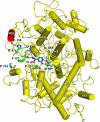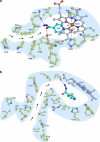Mode of binding of the tuberculosis prodrug isoniazid to heme peroxidases: binding studies and crystal structure of bovine lactoperoxidase with isoniazid at 2.7 A resolution
- PMID: 19907057
- PMCID: PMC2801281
- DOI: 10.1074/jbc.M109.060327
Mode of binding of the tuberculosis prodrug isoniazid to heme peroxidases: binding studies and crystal structure of bovine lactoperoxidase with isoniazid at 2.7 A resolution
Abstract
Isoniazid (INH) is an anti-tuberculosis prodrug that is activated by mammalian lactoperoxidase and Mycobacterium tuberculosis catalase peroxidase (MtCP). We report here binding studies, an enzyme assay involving INH, and the crystal structure of the complex of bovine lactoperoxidase (LPO) with INH to illuminate binding properties and INH activation as well as the mode of diffusion and interactions together with a detailed structural and functional comparison with MtCP. The structure determination shows that isoniazid binds to LPO at the substrate binding site on the distal heme side. The substrate binding site is connected to the protein surface through a long hydrophobic channel. The acyl hydrazide moiety of isoniazid interacts with Phe(422) O, Gln(423) O(epsilon1), and Phe(254) O. In this arrangement, pyridinyl nitrogen forms a hydrogen bond with a water molecule, W-1, which in turn forms three hydrogen bonds with Fe(3+), His(109) N(epsilon2), and Gln(105) N(epsilon2). The remaining two sides of isoniazid form hydrophobic interactions with the atoms of heme pyrrole ring A, C(beta) and C(gamma) atoms of Glu(258), and C(gamma) and C(delta) atoms of Arg(255). The binding studies indicate that INH binds to LPO with a value of 0.9 x 10(-6) m for the dissociation constant. The nitro blue tetrazolium reduction assay shows that INH is activated by the reaction of LPO-H(2)O(2) with INH. This suggests that LPO can be used for INH activation. It also indicates that the conversion of INH into isonicotinoyl radical by LPO may be the cause of INH toxicity.
Figures







Similar articles
-
The tuberculosis prodrug isoniazid bound to activating peroxidases.J Biol Chem. 2008 Mar 7;283(10):6193-200. doi: 10.1074/jbc.M707412200. Epub 2007 Dec 5. J Biol Chem. 2008. PMID: 18056997
-
Crystal structure of the catalase-peroxidase KatG W78F mutant from Synechococcus elongatus PCC7942 in complex with the antitubercular pro-drug isoniazid.FEBS Lett. 2015 Jan 2;589(1):131-7. doi: 10.1016/j.febslet.2014.11.037. Epub 2014 Dec 3. FEBS Lett. 2015. PMID: 25479089
-
Enzyme-catalyzed mechanism of isoniazid activation in class I and class III peroxidases.J Biol Chem. 2004 Sep 10;279(37):39000-9. doi: 10.1074/jbc.M402384200. Epub 2004 Jul 1. J Biol Chem. 2004. PMID: 15231844
-
Structural basis of activation of mammalian heme peroxidases.Prog Biophys Mol Biol. 2018 Mar;133:49-55. doi: 10.1016/j.pbiomolbio.2017.11.003. Epub 2017 Nov 22. Prog Biophys Mol Biol. 2018. PMID: 29174286 Review.
-
Isoniazid is not a lead compound for its pyridyl ring derivatives, isonicotinoyl amides, hydrazides, and hydrazones: a critical review.Curr Med Chem. 2006;13(18):2205-19. doi: 10.2174/092986706777935249. Curr Med Chem. 2006. PMID: 16918349 Review.
Cited by
-
Withdrawn.Infect Disord Drug Targets. 2012 Nov 16. Online ahead of print. Infect Disord Drug Targets. 2012. PMID: 23167715 Free PMC article.
-
CO binding and ligand discrimination in human myeloperoxidase.Biochemistry. 2010 Mar 16;49(10):2150-8. doi: 10.1021/bi9021507. Biochemistry. 2010. PMID: 20146436 Free PMC article.
-
A novel metabolite of antituberculosis therapy demonstrates host activation of isoniazid and formation of the isoniazid-NAD+ adduct.Antimicrob Agents Chemother. 2012 Jan;56(1):28-35. doi: 10.1128/AAC.05486-11. Epub 2011 Oct 28. Antimicrob Agents Chemother. 2012. PMID: 22037847 Free PMC article.
-
Mode of binding of the antithyroid drug propylthiouracil to mammalian haem peroxidases.Acta Crystallogr F Struct Biol Commun. 2015 Mar;71(Pt 3):304-10. doi: 10.1107/S2053230X15001806. Epub 2015 Feb 19. Acta Crystallogr F Struct Biol Commun. 2015. Retraction in: Acta Crystallogr F Struct Biol Commun. 2015 Jun;71(Pt 6):804. doi: 10.1107/S2053230X15006962. PMID: 25760705 Free PMC article. Retracted.
-
Isonicotinic acid hydrazide conversion to Isonicotinyl-NAD by catalase-peroxidases.J Biol Chem. 2010 Aug 20;285(34):26662-73. doi: 10.1074/jbc.M110.139428. Epub 2010 Jun 15. J Biol Chem. 2010. PMID: 20554537 Free PMC article.
References
-
- Kimura S., Ikeda-Saito M. (1988) Proteins Struct. Funct. Genet. 3, 113–120 - PubMed
-
- Welinder K. G. (1992) Curr. Opin. Struct. Biol. 2, 388–393
-
- Zeng J., Fenna R. E. (1992) J. Mol. Biol. 226, 185–207 - PubMed
-
- Singh A. K., Singh N., Sharma S., Singh S. B., Kaur P., Bhushan A., Srinivasan A., Singh T. P. (2008) J. Mol. Biol. 376, 1060–1075 - PubMed
-
- Gajhede M., Schuller D. J., Henriksen A., Smith A. T., Poulos T. L. (1997) Nat. Struct. Biol. 4, 1032–1038 - PubMed
Publication types
MeSH terms
Substances
Associated data
- Actions
- Actions
LinkOut - more resources
Full Text Sources

